Multiple genetic alterations within the PI3K pathway are responsible for AKT activation in patients with ovarian carcinoma
- PMID: 23408974
- PMCID: PMC3567053
- DOI: 10.1371/journal.pone.0055362
Multiple genetic alterations within the PI3K pathway are responsible for AKT activation in patients with ovarian carcinoma
Abstract
The phosphatidylinositol 3-kinase (PI3K)/AKT pathway is activated in multiple cancers including ovarian carcinoma (OC). However, the relative contribution of the single components within the PI3K pathway to AKT activation in OC is still unclear. We examined 98 tumor samples from Italian OC patients for alterations in the members of the PI3K pathway. We report that AKT is significantly hyperactive in OC compared to normal tissue (n = 93; p<0.0001) and that AKT activation is preferentially observed in the elderly (>58 years old; n = 93; p<0.05). The most frequent alteration is the overexpression of the p110α catalytic subunit of PI3K (63/93, ∼68%); less frequent alterations comprise the loss of PTEN (24/89, 27%) and the overexpression of AKT1 (18/96, 19%) or AKT2 (11/88,12.5%). Mutations in the PIK3CA or KRAS genes were detected at lower frequency (12% and 10%, respectively) whereas mutations in AKT1 or AKT2 genes were absent. Although many tumors presented a single lesion (28/93, of which 23 overexpressed PIK3CA, 1 overexpressed AKT and 4 had lost PTEN), many OC (35/93) presented multiple alterations within the PI3K pathway. Apparently, aberrant PI3K signalling was mediated by activation of the canonical downstream AKT-dependent mTOR/S6K1/4EBP1 pathway and by regulation of expression of oncogenic transcription factors that include HMGA1, JUN-B, FOS and MYC but not by AKT-independent activation of SGK3. FISH analysis indicated that gene amplification of PIK3CA, AKT1 and AKT2 (but not of PI3KR1) and the loss of PTEN are common and may account for changes in the expression of the corresponding proteins. In conclusion, our results indicate that p110α overexpression represents the most frequent alteration within the PI3K/AKT pathway in OC. However, p110α overexpression may not be sufficient to activate AKT signalling and drive ovarian tumorigenesis since many tumors overexpressing PI3K presented at least one additional alteration.
Conflict of interest statement
Figures




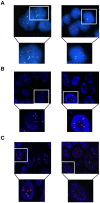

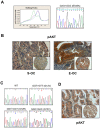
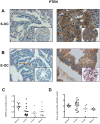
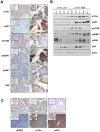
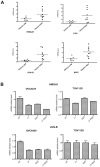
References
-
- Fishman DA, Bozorgi K (2001) The scientific basis of early detection of epithelial ovarian cancer: the national ovarian cancer early detection program (NOCEDP). In Cancer Treatment and Research: Ovarian Cancer. In: Stack MS, Fishman DA editors. Boston: Kluwer Academic Publishers. 3–28. - PubMed
-
- Fader AN, Rose PG (2007) Role of surgery in ovarian carcinoma. J Clin Oncol 25: 2873–2883. - PubMed
-
- Auersperg N, Wong AS, Choi KC, Kang SK, Leung PC (2001) Ovarian surface epithelium: biology, endocrinology, and pathology. Endocr Rev 22: 255–288. - PubMed
-
- Feeley KM, Wells M (2001) Precursor lesions of ovarian epithelial malignancy. Histopathology 38: 87–95. - PubMed
Publication types
MeSH terms
Substances
LinkOut - more resources
Full Text Sources
Other Literature Sources
Medical
Molecular Biology Databases
Research Materials
Miscellaneous

